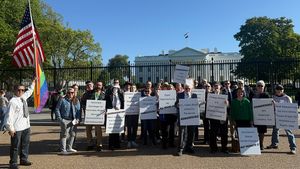Within the past week, the United States has been shaken by two eerily similar but equally violent incidents.
On Sunday, 16-year-old Ralph Yarl was shot in Kansas City after he accidentally rang the wrong doorbell when picking up his younger siblings. 84-year-old White homeowner, Andrew Lester, fired at the Black teen once through the door, then a second time when Yarl was already on the ground bleeding. Lester reportedly thought Yarl was breaking in, despite ringing the doorbell, and was "scared to death" by his size.
The day before, late Saturday night, a woman was killed in rural upstate New York when she and her friends mistakenly pulled into the wrong driveway, and were making efforts to turn around. Kaylin Gillis, 20, died after being struck by a bullet from Kevin Monahan, 65, who left his house to fire at the lost car.
Protests have already broken out across Kansas City, with activists decrying the racial overtones in Yarl's shooting. While both Gillis and her killer were White, the two cases have been compared for their uncanny similarities, and for their possible shared motivation: fear.
In reality, Yarl and Gillis posed no threat to the men who shot them, but their assailants still perceived one. While no other motivation has been cited in either case, both shooters were gun-owners in largely conservative areas — it may have to do with the narrative fed to them, and to those who identify with them.
According to a 2019 study in Nature, "most research comparing gun owners to non-gun owners suggests that ownership is rooted in fear." While many gun owners say they possess a firearm for the purpose of self-defense, those most likely to own guns are some of the least likely to face victimization.
"Gun ownership tends to be lower in urban settings and in low-income families where there might be higher rates of violence and crime," the report reads. "Instead, the largest demographic of gun owners in the US are white men living in rural communities who are earning more than $100K/year. ... These findings suggest a mismatch between subjective fear and objective reality."
Fear is exacerbated on the nightly news with "potential for bias" stories about violent crime. The NRA is also a major media force that "exploits current xenophobic sentiments" through a “disinformation campaign reliant on fearmongering."
Conservatives as a political party also engage in such fearmongering, pushing a narrative that paints liberal cities as violent and dangerous. While gun ownership is common among conservatives, the report also notes that the "belief in a dangerous world [is] associated with political conservatism."
This fear is also rooted in racism and toxic masculinity. In a sample of 20 predominantly-White men who had licenses for concealed handgun carry, "the men described how guns help to fulfill their identities as protectors of their families, while characterizing imagined dangers with rhetoric suggesting specific fears about Black criminals."
Pump your voters full of fear, then funnel guns into their hands, and it's no wonder that they respond through territorial violence.
Gillis tragically lost her life following the shooting in New York. Fortunately, Yarl was recently discharged from a Kansas City hospital and is on the path to healing. They are not the first victims of such incidents, and in the face of escalating conservative rhetoric, likely will not be the last.



















































